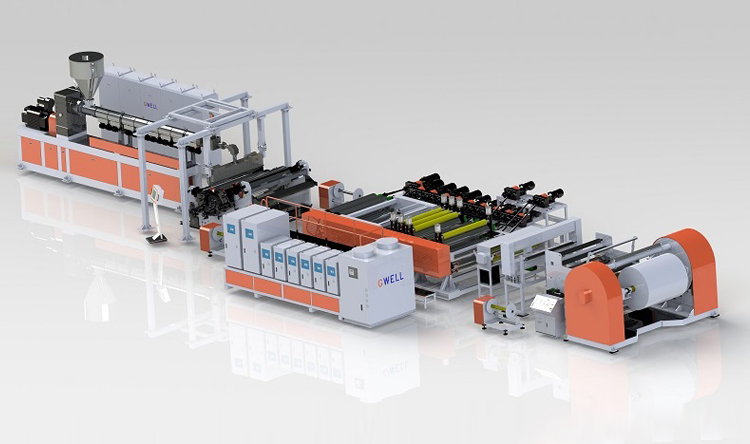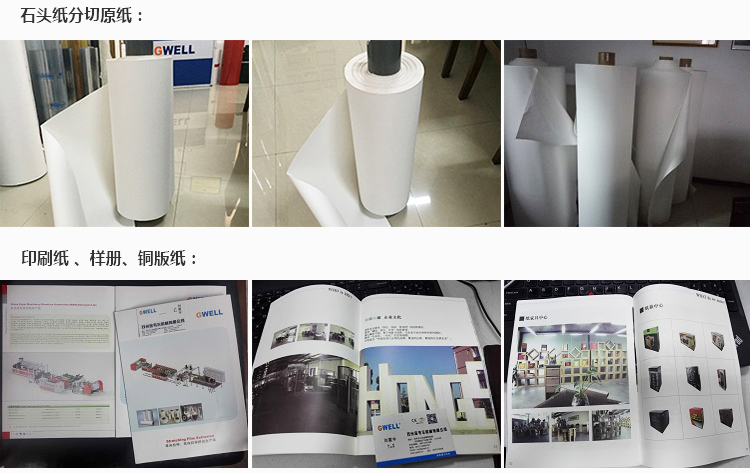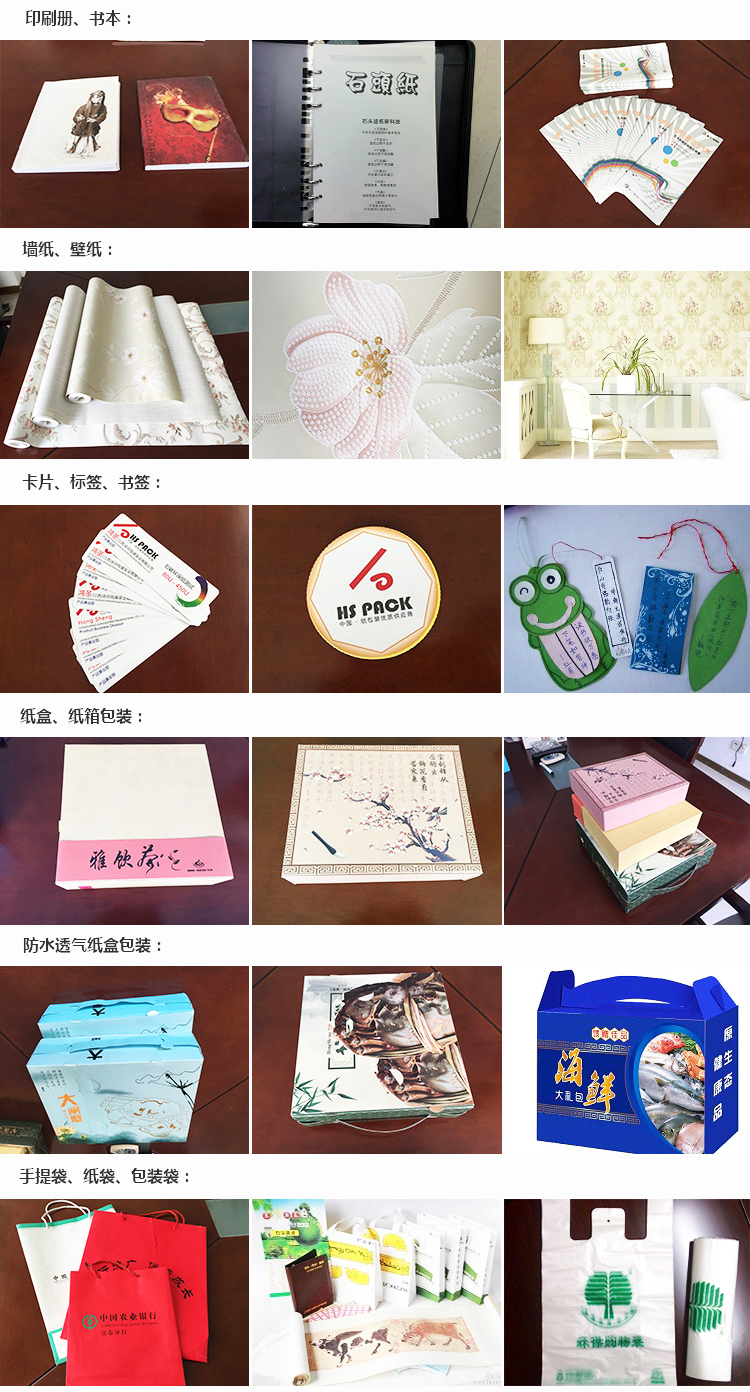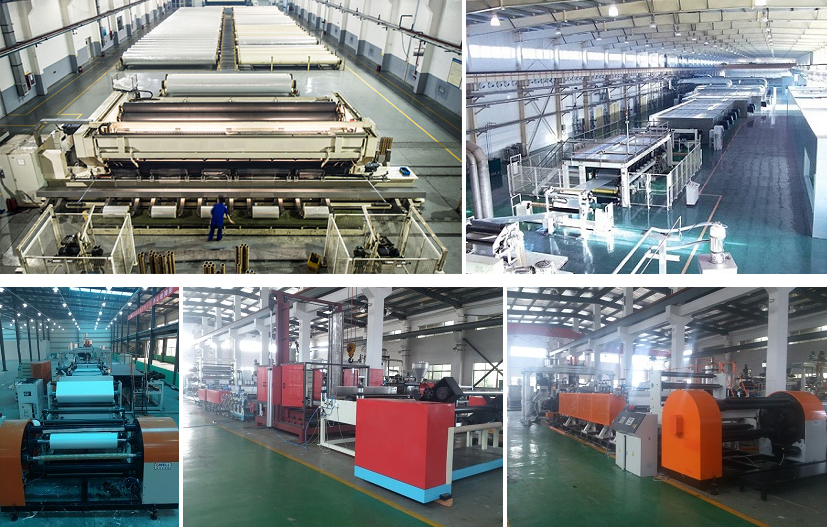Product Categories

(The picture shows the sixth generation Jinweier stone paper equipment, without coating)
1. Introduction to Stone Paper Products:
Stone paper is a new type of material that lies between paper and plastic. It can replace traditional functional paper and professional paper, as well as most traditional plastic packaging materials. And it has the characteristics of low cost and controllable degradation, which can save users a lot of costs without generating pollution. From the perspective of replacing traditional paper, it can save a lot of forest resources for society and reduce secondary pollution generated during the papermaking process; From the perspective of replacing traditional plastic packaging materials, it can save a large amount of strategic resources for the country (2.3 tons of oil can be saved for every 1 ton used), and the product can degrade after use without causing secondary white pollution. The environmentally-friendly new material stone paper industry has a wide range of materials, with a vast space for product upgrades, technological advancements, and expanded application areas. It is a highly dynamic sunrise industry.
2. Product features:
The production process of stone paper is simple; High investment, high output, and low energy consumption; Not using plant fibers or cutting down trees can save a lot of wood and protect the natural ecology; It does not require the addition of strong acids, strong alkalis, bleaching agents and other chemical raw materials, and does not discharge wastewater, waste residue, and toxic and harmful gases, making it a green and environmentally friendly product. The product has the characteristics of good mechanical performance, waterproof, moisture-proof, moth proof, folding resistant, tear resistant, oil resistant, non-toxic, odorless, pollution-free, stable geometric dimensions, high printing clarity, good effect, and can naturally degrade into powder and return to nature after use.
3. Product type:
Category 1: Series of biodegradable and environmentally friendly packaging materials. This product is mainly used to replace traditional plastic packaging series products; There are mainly two series of industrial packaging materials and household packaging materials, among which industrial packaging materials include dust covers and protective covers for products such as electronics, household appliances, and industrial instruments and equipment. Household packaging materials include various packaging bags, shopping bags, garbage bags, and continuous roll bags used in daily life. This type of product has strong social value and market advantages.
Social value lies in:
1. The product has photodegradation, oxidative degradation, and biodegradation properties. Long term use can fundamentally solve the problem of "white pollution" that is increasingly oppressing Mother Earth;
2. Due to the extensive use of calcium carbonate, using one ton of environmentally friendly packaging materials can save the country 2.3 tons of petroleum resources. The market advantage lies in that consumers not only bear social and environmental responsibilities when using it, but also save 15% to 30% of usage costs.
Category 2: Environmentally friendly stone wall paper series products. Due to advantages in raw materials, production technology, and process flow, stone paper wallpaper products are wall papers with almost zero benzene and zero formaldehyde in the world. The products have functional characteristics such as no harmful substances such as heavy metals, no odor, moisture-proof, flame retardant, and antibacterial, making significant breakthroughs in health and environmental protection! Meanwhile, due to the huge cost advantage of raw materials and the promotion of the new "one-stop sales service center" direct sales model, the selling price of environmentally friendly wall paper is 20% to 50% lower than that of similar products in the market
Category 3: Environmentally friendly stone paper series products. Mainly used to replace some traditional cultural paper, packaging paper, and special paper products; This type of product changes the traditional papermaking process technology, does not use wood pulp, does not need to cut down trees, does not discharge strong acids, alkalis, and other chemicals, and does not discharge wastewater.
4. Meaning:
The contribution of stone paper to the environment: Stone paper is made by completely dissolving a large amount of inorganic mineral powder into a small amount of non-toxic resin, with an environmentally friendly process. After use, it can self embrittle and return to the earth. If the recycled paper is sent to the incinerator for incineration, a small amount of non-toxic and harmless resin will not produce black smoke or toxic gas after incineration, and the remaining inorganic mineral powder can also return to the earth and nature.
5. Comparison:
The new wood pulp free stone paper takes into account many factors such as environmental costs, raw materials, processability, market acceptance, and future prospects. Although it has not fully replaced the traditional paper market, the printing quality of stone paper is similar to that of traditional paper, and it has the physical characteristics of synthetic paper. The following is a comparison of the differences between wood pulp paper, synthetic paper, and stone paper.
Recyclable: Stone paper products can be recycled through plastic product recycling channels after use. After collection, they can be crushed, extruded, and granulated into good additives for PE plastic processing. They can produce colored plastic bags, flower pots, plastic buckets, etc. When stone paper is used and treated as garbage, it is sent to the incinerator for combustion because it contains a large amount of stone powder and a small amount of non-toxic resin. Only non-toxic resin can be burned. When the resin burns, the stone powder will pulverize and promote the contact between the resin and air, accelerating the complete combustion of the resin. Therefore, there will be no black smoke generated due to oxygen deficiency and suffocation during combustion. After non-toxic resin combustion, there is no toxic exhaust gas, and the emission of carbon dioxide is the least, which can slow down the warming of the earth. After being discarded outdoors, stone paper will automatically crumble into a broken eggshell shape under sunlight for about six months, returning to nature (paper placed indoors will not be damaged by UV rays, and resin will not crumble).
Protecting water resources and energy conservation: Stone paper has a strong environmental awareness. The manufacturing of stone paper products does not require washing with water, nor does it require strong acids, alkalis, or bleaches. Therefore, there is no problem of wastewater discharge, and it does not pollute water resources such as rivers and oceans. In addition, the energy consumption in the process is lower than that of traditional wood pulp papermaking, which helps to improve global warming caused by carbon dioxide (CO2).
(This picture is the first generation model of Kinwell Stone Paper, which needs to be coated)
Stone Paper (PE+Calcium Carbonate) Unidirectional Stretch Extrusion Production Line Product Usage: The product has an extremely wide range of applications and can be used in disposable household consumables, such as garbage bags, shopping bags, food bags, compact bags, lunch boxes, foot covers, gloves, tablecloths, raincoats, dust covers, etc; It can also be applied to cultural paper, such as printing paper, writing paper, advertising and decoration paper, Daolin paper, coated paper, film paper, picture paper, poster paper, typing paper, postal paper, cigarette paper, Grassin paper, newsprint, etc; It can also be applied to building material decoration, such as decorative wallpaper, etc; It can also be applied in industrial packaging and other fields, such as fertilizer bags, cement bags, rice noodle bags, clothing bags, various handbags, paper boxes, cardboard boxes, etc; It can also be applied to special paper, such as paper for field operations, paper for underwater operations, paper for mining operations, and military special paper. It can be said that the application fields are very extensive, and with the continuous maturity and upgrading of stone papermaking technology, the application fields will be even larger. The cost of stone paper products is 20% -30% lower than that of alternative products, and it has strong competitiveness, with a very promising market prospect. Nowadays, stone paper has been widely used in wall wallpaper, book printing, food packaging, handbags, maps, posters, cards, etc. It has good properties such as environmental degradation, oil resistance, waterproofing, mold resistance, insect resistance, and tear
resistance.


Stone paper is divided into PP and PE, and the materials and papermaking methods are selected based on the purpose of the paper. Jinwei Company provides a complete set of solutions and turnkey engineering. The stone paper/synthetic paper production line includes three parts: material processing (granulation), salivation stretching (papermaking), and coating (paper surface treatment). Provide a complete set of solutions including factory planning and layout, technical training for stone paper production personnel, a complete set of equipment production lines, stone paper production processes, and formulas for various stages of stone paper production. We have provided multiple sets of stone paper turnkey projects both domestically and internationally, and have gained widespread recognition from our customers.
The processing methods are divided into: salivation stone paper/synthetic paper production line; Unidirectional stretching stone paper/synthetic paper production line; Biaxially stretched stone paper/synthetic paper production line.
Stone paper stretching production line parameters (please consult sales engineers for details)
| model | Single screw GWS130 | Single screw GWS130 | Single screw GWS150 |
| Product type | Spreading | Unidirectional stretching | Biaxial stretching |
| Product width | 810mm | 1400mm | 2800mm |
| Product thickness | 0.2mm -1.5mm | 0.1mm -0.5mm | 0.05mm -0.5mm |
| Annual output | 5000 t/yr | 5000 t/yr | 8000 t/yr |


